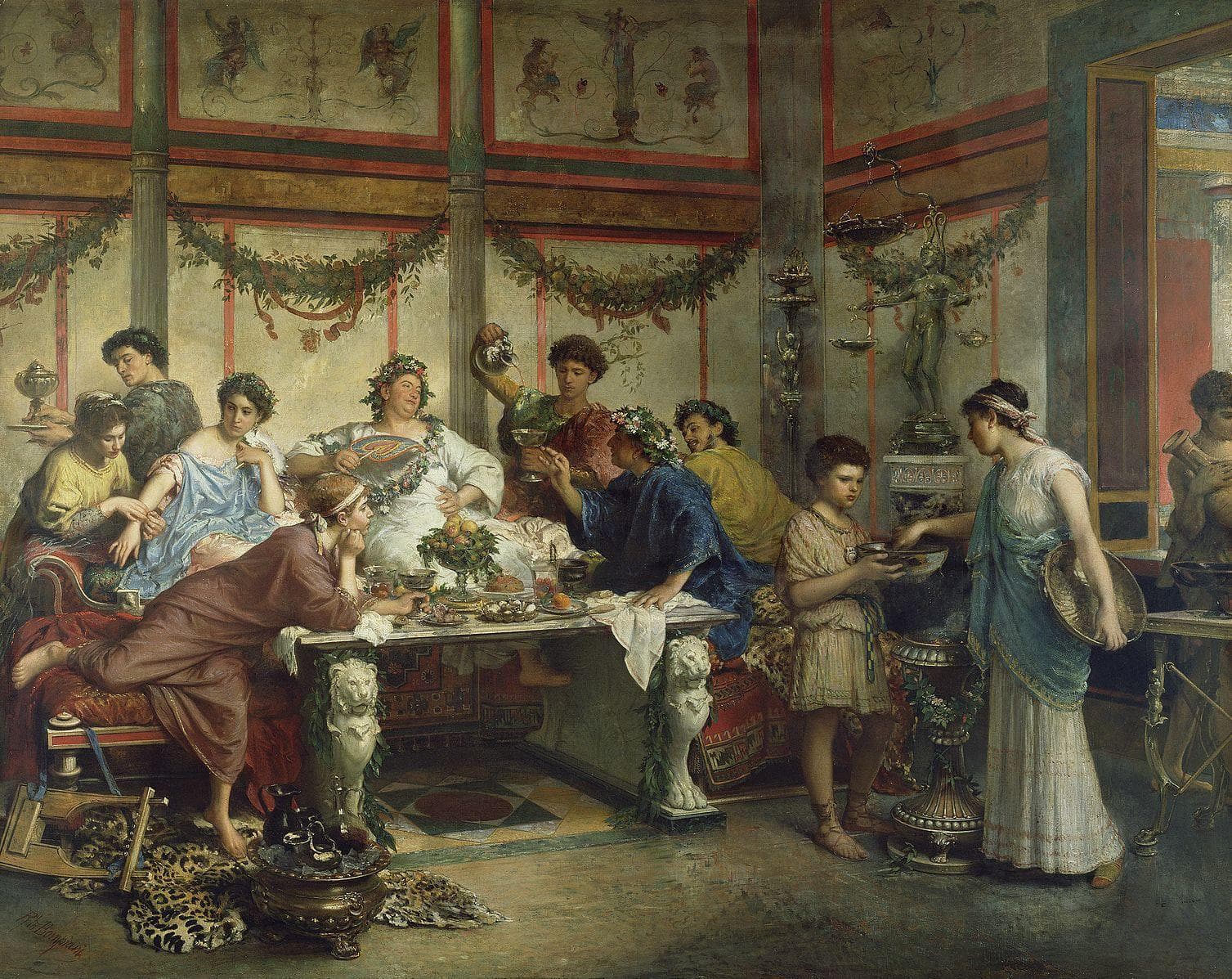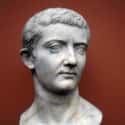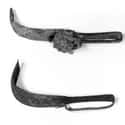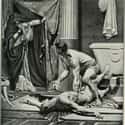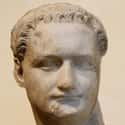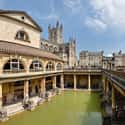-
(#1) Early Roman Emperors Often Kept Their Hair Short And Shaved Their Beards
Through the first half of the 1st century BC, Roman men commonly wore their hair and facial hair long. When Julius Caesar (100-44 BC) came to power, he became a model for shorter hair in general. According to Roman historian Suetonius,
[Caesar] was somewhat overnice in the care of his person, being not only carefully trimmed and shaved, but even having superfluous hair plucked out, as some have charged; while his baldness was a disfigurement which troubled him greatly, since he found that it was often the subject of the gibes of his detractors. Because of it he used to comb forward his scanty locks from the crown of his head, and of all the honors voted him by the senate and people there was none which he received or made use of more gladly than the privilege of wearing a laurel wreath at all times.
This became the norm for emperors, and Greek barbers were brought to Rome to maintain cleanly shaven appearances. Emperor Otho (32-69 AD) was said to have tried a different approach. Apparently, he shaved "every day, and since boyhood had always used a poultice of moist bread to prevent growth of his beard."
It wasn't until Hadrian (76-138 AD) that another Roman emperor wore a beard, and he may have done so to hide skin deformities on his face.
-
(#2) Contemporary Medicine Encouraged Emperors To Leave Their Acne Alone
Emperor Tiberius (42 BC-37 AD) was called "handsome" by Suetonius, though the author noted that he "would break out on a sudden with many pimples."
Acne wasn't without remedy during the 1st century. Medical writer Aulus Cornelius Celsus produced an entire treatise on health, cleanliness, and the treatment of various diseases and afflictions, including skin problems.
In his De Medicina, Celsus wrote, "To treat pimples and spots and freckles is almost a waste of time." However, in the event that one did attempt to remove them, Celsus prescribed the following treatment:
[Pimples are] best removed by the application of resin to which not less than the same amount of split alum and a little honey has been added. A spot is removed by equal quantities of galbanum and soda pounded in vinegar to the consistency of honey. With this the part is to be smeared, and after the lapse of several hours... it is washed off, and the place anointed lightly with oil.
-
(#3) Emperors, Like All Romans, Would Use A Sickle To Remove Sweat
In many ways, Roman bathing practices were consistent regardless of class. Emperors and common folk alike used a strigil - essentially a small sickle - to wipe away sweat and oil.
After exercising or bathing, Romans covered themselves in oil. They then used a strigil to scrape it off into a guttus, or small pitcher. The process was devoid of soap and was followed by a cold water rinse. Wealthy individuals had slaves scrape them, while poor bathers had to do it themselves.
Excess use of the strigil could have negative consequences. While the rinse after a good strigil scrape was meant to restore moisture, the process was irritating to the skin. Strigils were also quite sharp. Suetonius speculated that Emperor Augustus's "numerous callous places resembling ringworm" were "caused by a constant itching of his body and a vigorous use of the strigil."
-
(#4) Both Emperors And Common People Used The Public Baths
Public bathing in Rome was a communal activity enjoyed by members of the lower classes. Wealthy Romans would often have private baths, but as the Roman empire expanded, bathhouses were built in small and large settlements alike.
Noteworthy Romans frequented public baths by the 1st century BC. Augustus's mother Atia enjoyed public baths until she a bad experience at one in 63 AD. Seutonius recounted how, after a serpent crawled on her, Atia immediately "purified herself," but was unable to remove a mark on her body that retained "colors like a serpent." From that point forward, the author wrote, "she ceased ever to go to the public baths."
Emperor Hadrian was a common presence at public baths, which was welcomed by other patrons:
He often bathed in the public baths, even with the meanest crowd. And a jest of his made in the bath became famous. For on a certain occasion, seeing a veteran, whom he had known in the service, rubbing his back and the rest of his body against the wall, he asked him why he had the marble rub him, and when the man replied that it was because he did not own a slave, he presented him with some slaves and the cost of their maintenance.
Hadrian's act prompted other bathers to try for the same reward:
When [Hadrian] saw a number of old men rubbing themselves against the wall for the purpose of arousing the generosity of the Emperor, he ordered them to be called out and then to rub one another in turn.
-
(#5) Hadrian Prohibited Shared Public Baths Between The Sexes
Roman bath complexes, called thermae, featured several rooms. Baths functioned as gymnasiums, social spaces, steam rooms, and the site of other public services where men and women interacted freely. In many public facilities, there were separate rooms for male and female bathers, although they were linked.
Emperor Hadrian changed this so that there were "separate baths for the sexes." Later, Emperor Marcus Aurelius (121-180 AD) took things even further by "abolish[ing] common baths for both sexes."
After they were reinstated by his predecessor, Elagabalus, Emperor Septimius Severus (193-211 AD) also "forbade the maintenance in Rome of baths used by both sexes."
-
(#6) To Get Rid Of Toothaches, Emperors Had To Expel 'Small Worms' From Their Teeth
Treatment for dental pain was generally carried out by barbers or surgeons in imperial Rome. When a Roman developed a toothache, 1st-century physician Celsus advised the elimination of wine and hard foods. He further recommended:
Steam from hot water is to be applied by a sponge, and an ointment put on made from cyprus or iris oil, with a woollen bandage over it, and the head must be wrapped up... [with] whatever is applied to the teeth directly, none the less the ointment mentioned above must also be put on the jaws and covered over with wool.
When Emperor Claudius (10 BC-54 AD) developed a toothache, his doctor allegedly cured him by burning hyoscyamus seeds and rinsing his mouth with hot water. "In this way," the doctor wrote, "small worms are expelled." At the time, it was believed that cavities and tooth pains were caused by worms gnawing from inside the teeth.
-
(#7) Emperors Valued Urine Because Romans Used It To Clean Clothes
Romans didn't have soap in the modern sense, but they did find other ways to clean clothes. One of the most valuable resources for laundry service was urine. Romans used human and animal urine, which were both high in ammonia, to strip clothes of dirt and oil. Traders would gather this commodity from public toilets.
Taxes levied on urine generated revenue to pay Roman troops, a plan first instituted by Emperor Vespasian (9-79 AD). Vespasian's son, Titus, was repelled by the tax, which, according to Suetonius, led to the following exchange:
When Titus found fault with [Vespasian] for contriving a tax upon public conveniences, he held a piece of money from the first payment to his son's nose, asking whether its odor was offensive to him. When Titus said "No," he replied, "Yet it comes from urine."
-
(#8) Emperors Turned Bathing Into The Ultimate Luxury
Hadrian was a regular visitor at public baths, but Emperor Gallienus (218-268 AD) indulged in as many as six or seven baths daily during the summer months (he only bathed two or three times a day in the winter).
Emperors Gordian and Commodus were said to have bathed often. The latter often took his meals in the bath, and would eventually be slain in the bathroom after being given a glass of wine (or a piece of meat, depending on the source) laced with poison.
The toxic substance didn't end Commodus's life. It was Narcissus, a wrestler and Commodus's fitness coach, who asphyxiated the emperor in his bath. Cassius Dio described the scene:
They [Commodus's enemies] caused Marcia [Commodus's mistress] to administer poison to him in some beef. But the immoderate use of wine and baths, which was habitual with him, kept him from succumbing at once, and instead he vomited up some of it; and thus suspecting the truth, he indulged in some threats. Then they sent Narcissus, an athlete, against him, and caused this man to strangle him while he was taking a bath.
-
(#9) Emperors Enjoyed Private Toilets
Just like bathing in the Roman world, using the toilet was communal and lacked privacy. Public toilets had numerous seats lined up next to each other with holes that led to sewer systems.
Given the option, wealthy Romans had private toilets installed. At his villa near Trivoli, Emperor Hadrian commissioned several private toilets with marble seats and footrests. Many of the single-seat toilets were arranged in clusters, near dining halls, and designed for individuals of varying social ranks.
Archaeological evidence shows that some of these toilets contained bubbling fountains, which would be used to rinse the sponges that Romans used to cleanse themselves. There is also evidence of foundations and sink-like structures where the sponges would have been kept.
Though Hadrian and his fellow nobles may not have realized the health benefits at the time, private baths and toilets offered a more sanitary alternative to the public Roman bathhouses, which were rife with parasites and disease.
-
(#10) Marcus Aurelius Had Strong Opinions About Bad Breath And Body Odor
The stoic Emperor Marcus Aurelius compared thoughts and words to bodily emanations. In his Meditations, he drew the following analogy:
Art thou angry with him whose armpits stink? Art thou angry with him whose mouth smells foul? What good will this danger do thee? He has such a mouth, he has such armpits: it is necessary that such an emanation must come from such things - but the man has reason, it will be said, and he is able, if he takes pain, to discover wherein he offends - I wish thee well of thy discovery.
Similarly, he wrote that telling someone they have bad breath requires tact akin to reminding them of flawed reason.
In his later writings, Marcus Aurelius was adamant that cleanliness was something one could - and should - manage and strive to improve, just like rational thought. This contrasted with his earlier cynical beliefs, ones that seemed to have steered him away from upkeep of his personal hygiene.
-
(#11) Imperial Table Manners Meant Fancy Napkins And Political Manipulation
Though they didn't keep a formal court, Roman emperors often dined with friends, nobles, and family members. Behavior and fare at the dinner table depended on the emperor. Suetonius described Augustus as "a light eater... and as a rule ate of plain food."
Suetonius painted a much different picture of Claudius:
[He] was eager for food and drink at all times and in all places... he hardly ever left the dining-room until he was stuffed and soaked; then he went to sleep at once, lying on his back with his mouth open, and a feather was put down his throat to relieve his stomach.
Few Roman emperors cultivated such a gluttonous reputation, but even those with a taste for fine dining did so at the expense of their guests. Caligula (12-41 AD) reportedly "allowed" some high-ranking senators "to run in their togas for several miles beside his chariot and to wait on him at table, standing napkin in hand either at the head of his couch, or at his feet." Two centuries later, Elagabalus amused himself by enjoying a number of savory dishes while his fellow diners received only napkins embroidered with the food he was eating.
Emperor Severus Alexander (208-235 AD) preferred clean, uncomplicated meals. "His banquets were neither sumptuous nor yet too frugal, but always characterized by the greatest good-taste," Suetonius wrote. "None but white napkins were used."
-
(#12) Baldness Prompted Emperors To Wear Wigs
Short haircuts were common among emperors, but few relished a thin or fading hairline. According to Suetonius, Emperor Domitian (51-96 AD) wrote a book called On the Care of the Hair, which reads:
Do you not see that I am too tall and comely to look on?
And yet the same fate awaits my hair, and I bear with resignation the aging of my locks in youth. Be assured that nothing is more pleasing than beauty, but nothing shorter-lived.
Displeased with his own hair loss, Domitian had himself depicted in coins and statuary with a full head of hair, and wore a wig later in life.
One of his predecessors, Otho, also wore a hairpiece to hide "the thinness of his locks." Suetonius claimed the wig was "so carefully fashioned and fitted to his head, that no one suspected it."
Emperor Caracalla (188-217 AD) wore a wig as well, but not to hide a balding head. During a tour of the empire, he became "especially fond of the Germans," to the point that he preferred German clothes to his Roman cloak and donned "a yellow wig with the locks arranged in German style."
The Germans were "delighted with the emperor's antics," Suetonius wrote, and "became very fond of him" in turn - though this may have had more to do with his "lavish gifts of money" than his fashion sense.
-
(#13) Augustus's Chief Deputy Designed The First Thermae
Larger public bathing facilities in Rome were known as "thermae." These were often commissioned by emperors and served as a location for socialization.
Thermae featured dressing rooms with holes in the walls for patrons to store their belongings, a tepidarium which contained a pool of warm water, a caldarium which contained a pool of hot water, and a frigidarium which contained a pool of cold water. Some thermaes even had outdoor swimming pools, dry saunas, and a gymnasium.
The very first thermae, which succeeded the smaller bath houses that came before it, was commissioned by Augustus and designed by his chief deputy, Agrippa, in 25 BC. After that, Roman emperors began commissioning larger and more elaborate thermae for public bathing purposes.
-
(#14) Emperor Hadrian Was The First To Reserve Private Baths For The Ill
Medical doctors, such as Aulus Cornelius Celsus who lived the the first century CE, suggested those who fell ill with diseases such as dysentery, typhus, malaria, tuberculosis, paralysis, cholera, gonorrhea, rabies, and so on, should cleanse themselves in a bath.
The problem with this is that most people attended public bathing facilities, including the ill. Emperor Hadrian was the one who finally suggested reserving times in which the bath houses would be open only to the sick, preventing the mingling of threatening germs.
New Random Displays Display All By Ranking
About This Tool
Hygiene in ancient Rome includes the famous public Roman baths, toilets, exfoliating cleaners, public facilities, and usually with high standards of cleanliness. The ancient Romans paid special attention to the cleaning of daily life, and the ancient Roman emperors had perfect cleaning procedures and luxurious bathroom accessories. The Romans, including women and slaves, would wash every day, if not more frequently, there would be a thorough bath at every festival.
Most ancient Roman emperors cared about beauty and cleanness includes hair removal, not just men’s beards, such as Julius Caesar. The random tool described 14 details about what hygiene was like for an ancient Roman emperor.
Our data comes from Ranker, If you want to participate in the ranking of items displayed on this page, please click here.






